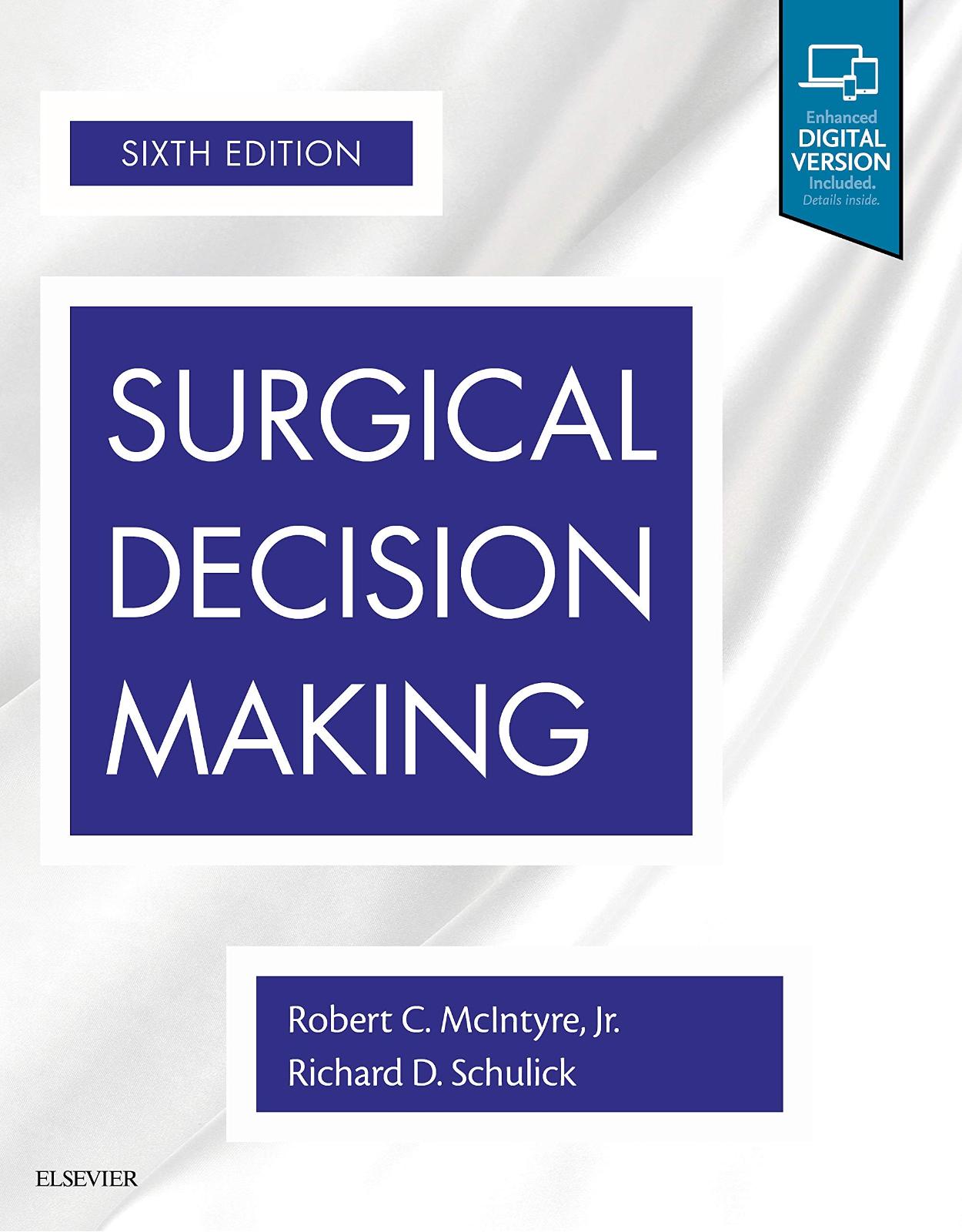
Surgical Decision Making, 6e
Livrare gratis la comenzi peste 500 RON. Pentru celelalte comenzi livrarea este 20 RON.
Disponibilitate: La comanda in aproximativ 4 saptamani
Editura: Elsevier
Limba: Engleza
Nr. pagini: 508
Coperta: Hardcover
Dimensiuni: 21.59 x 2.29 x 27.31 cm
An aparitie: 1 Mar. 2019
Description:
Using a proven, practical, algorithmic approach, Surgical Decision Making summarizes evidence-based guidelines and practice protocols in an easy-to-follow format. Designed to sharpen the decision-making skills of both trainees and practicing surgeons, the 6th Edition directs your focus to the critical decision points in a wide range of clinical scenarios, helping you determine optimal evaluation and management to secure the best possible patient outcomes. Algorithms are accompanied by annotations that explain all critical factors affecting decisions in a concise, readable manner.
Reflects the scope of practice of today’s general surgeon, with fresh, expert perspectives from new editor Dr. Richard Schulick and numerous new contributors.
Contains 58 new chapters and thoroughly revised content throughout.
Includes new coverage of Preoperative Evaluation of the Geriatric Patient, Pancreatic Cystic Neoplasm, Familial Breast Cancer, Resuscitative Endovascular Balloon Occlusion of the Aorta, Blunt Cerebrovascular Injury, and much more.
Uses an easy-to-follow, consistent format, with an algorithm on one page and short descriptions explaining the various steps in the decision-making process on the opposite page.
Includes explanatory notes that summarize presenting signs and symptoms, laboratory investigation, diagnostic modalities, surgical therapies, and adjuvant therapies for each condition.
Encompasses both general surgery and surgical subspecialties―helping you directly manage a broad range of problems.
Emphasizes information that frequently appears on board exams.
Table of Contents:
Part I Perioperative Care
Chapter 1 Preoperative Laboratory Evaluation
References
Chapter 2 Preoperative Cardiac Evaluation
References
Chapter 3 Preoperative Pulmonary Evaluation
Conclusions
References
Chapter 4 Bleeding Disorders in Surgical Patients
References
Chapter 5 Hypercoagulable Patient
References
Chapter 6 Postoperative Fever
References
Chapter 7 Bridge Anticoagulation
References
Chapter 8 Intraabdominal Infection
References
Chapter 9 Preoperative Evaluation of the Geriatric Patient
Geriatric Patients
Establishing Advance Directives
Preoperative High-Risk Screening
Patient-Centered Operative Decision Making
Tailoring of Surgical Recommendations
Preoperative Optimization
References
Part II Critical Care
Chapter 10 Cardiopulmonary Resuscitation
References
Chapter 11 Perioperative Arrhythmia
History and Physical
Preoperative Evaluation and Testing
Cardiovascular Implantable Electronic Device (CIED)
Tachyarrhythmias
Bradyarrhythmias
References
Chapter 12 Perioperative Myocardial Ischemia and Infarction
References
Chapter 13 Shock
Introduction
References
Chapter 14 Goal-Directed Resuscitation
References
Chapter 15 Pulmonary Embolism
References
Chapter 16 Ventilator-Associated Pneumonia
References
Chapter 17 Nutritional Support
References
Chapter 18 Acute Respiratory Failure
Noninvasive Ventilation
Invasive Mechanical Ventilation
Systemic and Hemodynamic Treatment
Sedation and Pain Control
Protocolized Ventilator Weaning
Consider Extubation
Tracheostomy
Low-Tidal-Volume Ventilation
High-PEEP Open Lung Strategy
Restrictive Fluid Strategy
Neuromuscular Blockade
Inhaled Nitric Oxide
Prone Position
Recruitment Maneuvers
Esophageal Pressure, High-Frequency Oscillatory Ventilation, and Airway Pressure-Release Ventilation
Extracorporeal Membrane Oxygenation
References
Chapter 19 Acute Hypoxic Event
References
Chapter 20 Acute Renal Failure
Introduction
Conclusions
References
Chapter 21 Acid–Base Disorders
References
Chapter 22 Sodium Disorders
Introduction
Conclusion
References
Chapter 23 Potassium Disorders
References
References
Chapter 24 Calcium Disorders
References
Chapter 25 Hypothermia
References
Part III Head & Neck
Chapter 26 Neck Mass
References
Chapter 27 Nonmelanoma Skin Cancer of the Face
References
Chapter 28 Management of Melanoma of the Head and Neck
Suspicious Cutaneous Lesions of the Head and Neck
Palpable Mass in the Parotid Gland or Neck in Patient With Cutaneous Melanoma
Benign Lesions
Premalignant Lesion
Early-Stage Melanoma—Tis and T1
Invasive Melanoma > 1 mm Thick
Positive FNAB
Negative FNAB
Nondiagnostic FNAB
Sentinel Lymph Node Biopsy
Sentinel Node Negative
Positive Sentinel Node
References
Part IV Thoracic
Chapter 29 Lung Nodule
References
Chapter 30 Mediastinal Tumors
Introduction
References
Chapter 31 Pleural Effusion and Empyema
References
Part V Alimentary Tract
Chapter 32 Achalasia
References
Chapter 33 Esophageal Motility Disorders (Other Than Achalasia)
References
Chapter 34 Esophageal Perforation
References
Chapter 35 Caustic Ingestion
References
Chapter 36 Gastroesophageal Reflux Disease
References
Chapter 37 Barrett's Esophagus
References
Chapter 38 Esophageal Diverticulum
References
Chapter 39 Paraesophageal Hiatal Hernia
Initial Assessment
Surgical Management
References
Chapter 40 Gastric Ulcer
References
Chapter 41 Duodenal Ulcer
References
Chapter 42 Morbid Obesity
References
Chapter 43 Upper GI Bleeding
References
Chapter 44 Bleeding Esophageal Varices
References
Chapter 45 Jaundice
References
Chapter 46 Obstructive Jaundice
References
Chapter 47 Cholelithiasis
References
Chapter 48 Choledocholithiasis
References
Chapter 49 Hepatic Abscess
References
Chapter 50 Cystic Liver Disease
References
Chapter 51 Solid Liver Lesion
References
Chapter 52 Acute Pancreatitis
References
Chapter 53 Chronic Pancreatitis
References
Chapter 54 Pancreatic Pseudocysts
References
Chapter 55 Pancreas Divisum
History and Physical Examination
Differential Diagnosis
Physical Findings, Imaging, and Labs
Pancreatic Divisum
Asymptomatic/Incidental Finding
Symptomatic
Mild Symptoms Without Pancreatitis
Severe Acute Pancreatitis and Abdominal Pain
Chronic Pancreatitis and Abdominal Pain
Treatment: Endoscopic Approach
Treatment: Surgical
Postprocedure Management
Surgical Postoperative Management
References
Chapter 56 Small Bowel Obstruction
Introduction
References
Chapter 57 Acute Mesenteric Vascular Occlusion
References
Chapter 58 Short Bowel Syndrome
References
Chapter 59 Enterocutaneous Fistula
References
Chapter 60 Crohn's Disease of the Small Bowel
References
Chapter 61 Right Lower Quadrant Pain
References
Chapter 62 Volvulus
References
Chapter 63 Diverticulitis
References
Chapter 64 Lower Gastrointestinal Bleeding
References
Chapter 65 Ulcerative Colitis
References
Chapter 66 Ischemic Colitis
Introduction
References
Chapter 67 Toxic Megacolon
References
Chapter 68 C. dif Colitis
References
Chapter 69 Large Bowel Obstruction
References
Chapter 70 Rectal Prolapse
References
Chapter 71 Constipation
Introduction
References
Chapter 72 Appendicitis
References
Chapter 73 Anorectal Abscess and Fistula-in-Ano
References
Chapter 74 Hemorrhoids
References
Chapter 75 Pilonidal Disease
References
Chapter 76 Anal Fissure
References
Chapter 77 Groin Hernia
References
Chapter 78 Ventral Hernia
References
Part VI Oncology
Chapter 79 Cancer of Unknown Primary
References
Chapter 80 Esophageal Cancer
References
Chapter 81 Gastric Cancer
References
Chapter 82 Cholangiocarcinoma
References
Chapter 83 Hepatocellular Carcinoma
References
Chapter 84 Gallbladder Carcinoma
References
Chapter 85 Gastrointestinal Stromal Tumors (GISTs)
References
Chapter 86 Pancreatic Neuroendocrine Tumors
References
Chapter 87 Periampullary Carcinoma
References
Chapter 88 Pancreatic Cystic Neoplasms
References
Chapter 89 Pancreatic Mass
References
Chapter 90 Retroperitoneal Mass
References
Chapter 91 GI Lymphoma
Introduction
References
Chapter 92 Colon Polyp
References
Chapter 93 Colon Cancer
References
Chapter 94 Rectal Cancer
References
Chapter 95 Anal Cancer
References
Chapter 96 Metastatic Colorectal Carcinoma
References
Chapter 97 Breast and Soft Tissues
References
Chapter 98 Gynecomastia
References
Chapter 99 Palpable Breast Mass
References
Chapter 100 Nonpalpable Breast Lesions
References
Chapter 101 Early Breast Cancer
References
Chapter 102 Advanced Breast Cancer
References
Chapter 103 Recurrent Breast Carcinoma
References
Chapter 104 Familial Breast Cancer
Hereditary Breast and Ovarian Cancer Syndrome Testing Criteria
Cancer Genetics in the Era of Multigene Testing
Clinical Guidelines for Patients With a Known Genetic Predisposition to Breast Cancer
References
Chapter 105 Breast Reconstruction
References
Chapter 106 Soft Tissue Masses of the Extremities
Introduction
Clinical Assessment
Biopsy and Imaging
Staging
Tumor Biology Determines Resectability and Management
References
Chapter 107 Cutaneous Melanoma
References
Chapter 108 Nonmelanoma Skin Cancer
References
Part VII Endocrine
Chapter 109 Thyrotoxicosis
References
Chapter 110 Thyroid Nodule
Introduction
References
Chapter 111 Well-Differentiated Thyroid Cancer
References
Chapter 112 Medullary Thyroid Carcinoma
References
Chapter 113 Hypercalcemia and Hyperparathyroidism
References
Chapter 114 Hypoglycemia and Insulinoma
References
Chapter 115 Zollinger-Ellison Syndrome
References
Chapter 116 Adrenal Incidentaloma
References
Chapter 117 Pheochromocytoma
References
Chapter 118 Cushing's Syndrome
References
Chapter 119 Primary Aldosteronism
References
Part VIII Trauma
Chapter 120 Initial Evaluation and Resuscitation
Primary Survey
Adjuncts
Assess Need for Resuscitation
Secondary Survey
Begin Resuscitation
Control Hemorrhage
Restore Blood Oxygen-Carrying Capacity and Correct Coagulopathy
Serial Complete Blood Counts
Serial Thromboelastograms
Correct Metabolic Derangements
Reassessment
References
Chapter 121 Airway Management
References
Chapter 122 Cervical Spine Injury
Introduction
References
Chapter 123 Resuscitative Endovascular Balloon Occlusion of the Aorta (REBOA)
References
Chapter 124 Emergency Department Thoracotomy
References
Chapter 125 Penetrating Neck Trauma
References
Chapter 126 Blunt Cerebrovascular Injury
References
Chapter 127 Rib Fractures
References
Chapter 128 Hemo-Pneumothorax
References
Chapter 129 Blunt Thoracic Aortic Injury
Introduction
Mechanism of Injury
Diagnostic Imaging—CTA Chest
Grading of Injury
Medical Management of Grade I Injuries
Semi-Elective TEVAR for Grade II or III Injuries
Emergency TEVAR for Grade IV Injuries
Coverage of Left Subclavian Artery Management
Follow-Up Imaging
References
Chapter 130 Blunt Cardiac Injury
References
Chapter 131 Annotations to Thoracoabdominal Trauma
References
Chapter 132 Blunt Abdominal Trauma
References
Chapter 133 Penetrating Abdominal Injury
References
Chapter 134 Blunt Splenic Injury
References
Chapter 135 Liver Injury
References
Chapter 136 Abdominal Vascular Injuries
References
Chapter 137 Pancreatic Injury
References
Chapter 138 Duodenal Injury
References
Chapter 139 Penetrating Injury of the Colon
References
Chapter 140 Penetrating Rectal Injury
References
Chapter 141 Damage-Control Laparotomy
References
Chapter 142 Abdominal Compartment Syndrome
References
Chapter 143 Traumatic Hematuria
References
Chapter 144 Renal Injury
References
Chapter 145 Ureteral Injuries
References
Chapter 146 Bladder and Urethral Trauma
References
Chapter 147 Pelvic Fractures
References
Chapter 148 Closed Head Injury
References
Chapter 149 Cervical Spine Fractures
Cervical Spine Precautions
Fracture Anatomy
Neurologic Status
Stability
Disposition
References
Chapter 150 Spinal Cord Injury
Introduction
Special Considerations
Conclusion
References
Chapter 151 Popliteal Artery Injury
References
Chapter 152 Burns
References
Chapter 153 Acute Frostbite
Prehospital or Emergency Department Management
Rapid External Rewarming
Thrombolytic Therapy
Contraindications to the Thrombolytic Protocol
Post-Rewarming Management
References
Chapter 154 Electrical Burn Injury
Potential Complications After Electrical Injury
References
Index
| An aparitie | 1 Mar. 2019 |
| Autor | Robert C. McIntyre MD, Richard Schulick MD |
| Dimensiuni | 21.59 x 2.29 x 27.31 cm |
| Editura | Elsevier |
| Format | Hardcover |
| ISBN | 9780323525244 |
| Limba | Engleza |
| Nr pag | 508 |
-
1,20900 lei 1,05700 lei


















Clientii ebookshop.ro nu au adaugat inca opinii pentru acest produs. Fii primul care adauga o parere, folosind formularul de mai jos.